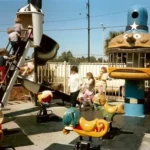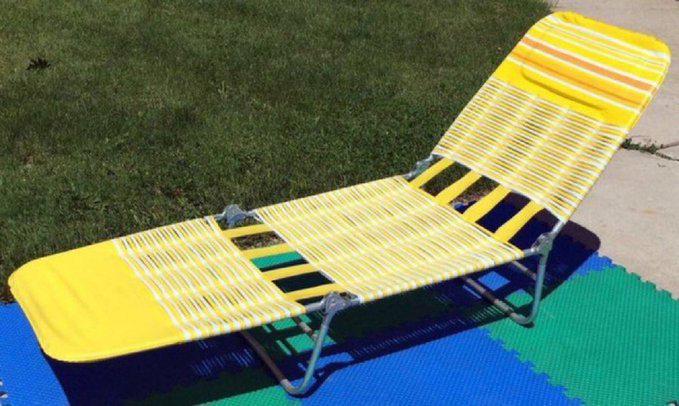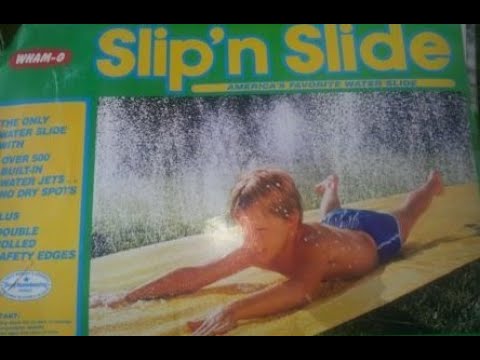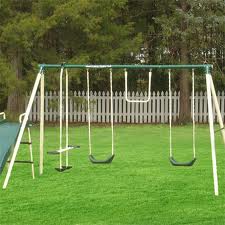 For kids growing up in the 1980s, a trip to McDonald’s wasn’t just about getting a Happy Meal. It was about something far more magical: the playground. With their whimsical fiberglass characters, twisty slides, and unmistakable scent of fryer grease mingling with plastic and rust, McDonald’s playgrounds were like miniature theme parks grafted onto the side of every suburban fast food joint. They were sticky, squeaky, often slightly dangerous—and completely unforgettable.
For kids growing up in the 1980s, a trip to McDonald’s wasn’t just about getting a Happy Meal. It was about something far more magical: the playground. With their whimsical fiberglass characters, twisty slides, and unmistakable scent of fryer grease mingling with plastic and rust, McDonald’s playgrounds were like miniature theme parks grafted onto the side of every suburban fast food joint. They were sticky, squeaky, often slightly dangerous—and completely unforgettable.
In the age before smartphones, iPads, and indoor trampoline parks, the McDonald’s playground was where kids unleashed their wild energy while parents attempted to sip lukewarm coffee in relative peace. It was a space fueled by branding, innovation, and a surprisingly complex vision of what fast food could represent in American family life.
The Birth of the McDonaldland Concept
The concept of a McDonald’s playground was rooted in marketing. In the 1970s, McDonald’s created an elaborate fictional universe called McDonaldland, populated with surreal mascots: Ronald McDonald, the Hamburglar, Grimace, Birdie the Early Bird, Captain Crook, the Fry Guys, and more. Inspired loosely by “H.R. Pufnstuf” and other trippy children’s programming of the late ’60s and early ’70s, McDonaldland was designed to give the fast food chain a fantasy identity that could rival Disney.
These characters weren’t just used in commercials and Happy Meal toys. McDonald’s wanted kids to feel like they were inside McDonaldland—and so they built it. By the late 1970s and into the 1980s, restaurants across the U.S. were retrofitted or newly constructed to include colorful outdoor playgrounds filled with bizarre fiberglass statues, crawl tunnels, and metallic contraptions that brought the characters to life in 3D form.
Iconic Playground Fixtures of the 1980s
Ask anyone who grew up in the ’80s about McDonald’s playgrounds, and you’ll likely hear the same lineup of structures. Some were fun, some frightening, and all were unforgettable:
-
The Hamburglar Jail: A climb-in, cylindrical cage structure that resembled a giant jail cell suspended on stilts. Kids would climb up inside and pretend to be captured. The bars were narrow, the steel was hot in the summer, and the entire idea was built around glorifying a cartoon thief.
-
Mayor McCheese Climber: A gigantic Mayor McCheese head, often with a ladder leading up into it and a small crawl space inside. The idea of climbing into a giant cheeseburger head should have been terrifying, but it was strangely magnetic.
-
Grimace Spinner: A Merry-Go-Round style ride with a huge, squat purple Grimace in the center. Kids would hang on to metal bars and spin themselves dizzy. It was equal parts exhilarating and vomit-inducing after scarfing down a cheeseburger.
-
Fry Guy Spring Riders: Like classic spring-mounted playground animals, but in the shape of Fry Guys with googly eyes and oversized feet. They were comical and often lopsided, but kids loved bouncing on them.
-
Big Mac Climber: Similar to the Mayor McCheese, the Big Mac version was a towering jail-like climber that felt oddly industrial. It was part fast food, part prison-industrial complex, and all surreal.
-
The Slide: A towering, sometimes metal, sometimes plastic spiral slide that became unbearably hot in the summer sun. Many kids learned about friction burns and static shock thanks to the McDonald’s slide.
These were not gentle padded environments. This was the era before most playground safety standards were in place. Everything was steel, hard plastic, and concrete. There were no foam surfaces or air-conditioned interiors. You might leave with a scraped knee or a mild concussion, but you’d leave smiling.
Why It Worked: Branding and Experience
The genius of the 1980s McDonald’s playground was that it transformed a meal into a full experience. Ronald McDonald was no longer just a clown on TV—he was someone you could see standing in fiberglass form near the front doors. The playground connected kids with the McDonaldland fantasy and made it real, and that had a powerful impact on brand loyalty.
Parents were also subtly targeted. With the playground acting as a babysitter, adults could relax inside and enjoy a meal—or, more accurately, try to wrangle their kids with a milkshake while hoping no one got hurt. It extended the time spent at the restaurant, increased food sales, and added a new layer to the McDonald’s value proposition. It wasn’t just a place to eat—it was a destination.
Indoor Playlands: The Next Evolution
By the mid-to-late 1980s, McDonald’s began experimenting with indoor Playlands, a concept that would eventually take over in the ’90s and beyond. These indoor facilities included padded climbing structures, tube slides, and ball pits. Though safer and more sanitary (in theory), they lacked the strange, free-range danger of their outdoor predecessors.
Still, the shift to indoor play spaces showed just how central the idea of play had become to McDonald’s branding. Playlands helped set McDonald’s apart from competitors like Burger King or Wendy’s, neither of which developed the same fully integrated fantasy branding. Even Chuck E. Cheese, as kid-focused as it was, never had the outdoor presence that McDonald’s achieved in the 1980s.
Cultural Impact and Symbolism
The McDonald’s playground of the ’80s was more than a fun pit stop—it was a cultural mirror. It reflected:
-
Suburban expansion, as fast food chains grew with the sprawl of highways and mini-malls
-
Corporate branding ingenuity, building worlds that hooked children early
-
A shift in parenting, where a fast food visit was no longer a rare treat but part of regular life
-
Nostalgia-driven design, with aesthetics that now feel psychedelic and haunting in hindsight
These playgrounds became a kind of communal experience. Generations of children remember the clang of metal, the odd squeak of climbing tubes, and the occasional terror of being stuck in a hot Mayor McCheese head. They were places where kids from all backgrounds played side by side, bonded over Chicken McNuggets, and created memories that outlasted the structures themselves.
The Slow Decline
By the mid-1990s, safety regulations tightened. Lawsuits began piling up. Parents became more cautious, and McDonald’s slowly phased out the iconic outdoor playgrounds. Many structures were removed or replaced with safer, more sanitized indoor alternatives. By the 2000s, most of the original fiberglass characters were gone—sold off, junked, or relegated to collectors’ basements.
Today, it’s rare to find a functioning 1980s-style McDonald’s playground still intact. A few do exist, mostly in rural or lesser-updated locations, acting like playground time capsules. But for most, the memory survives only in family photo albums, vintage VHS tapes, and the warm haze of nostalgia.
Collectibility and Cultural Resurrection
As ‘80s and ‘90s nostalgia surged in the 2010s and 2020s, so too did interest in the lost world of McDonaldland. Fiberglass statues of Grimace or the Hamburglar now fetch high prices on auction sites. YouTube channels and Instagram accounts are dedicated to exploring abandoned PlayPlaces or restoring old statues. Even McDonald’s has leaned into retro branding occasionally, releasing throwback Happy Meal boxes or commercials referencing McDonaldland characters.
There is something haunting and beautiful about these playgrounds today. They were so specific to their time—bright, bold, a little reckless—and they represent a moment in American childhood that can’t be replicated.
Conclusion: The Golden Arches Playground Lives On—In Memory
The McDonald’s playground of the 1980s was loud, chaotic, colorful, and slightly unhinged—just like childhood itself. It turned a basic hamburger chain into a wonderland of physical and imaginative play, where French fry goblins and hamburger-headed mayors ruled over kingdoms of sticky joy. It helped define what it meant to grow up in the ’80s and provided a uniquely American blend of commerce, imagination, and community.
Though they’re mostly gone now, replaced by safer and more generic spaces, the memory of those playgrounds lives on in the minds of millions. For a generation, the McDonald’s playground wasn’t just part of a meal—it was the main course.


